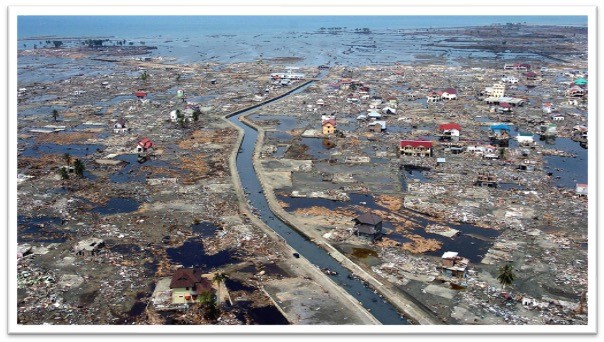By Melissa Ashbaugh

As a master’s student nearing the halfway mark of my program, I often wonder about what it means to have a career in natural hazards resiliency. I know that land use practices and anthropogenic climate change have increased hazard risk and that I’m interested in creating changes to protect people and resources. But how do you get from an interest to a career? And what motivates someone to persist in a field where the bad news seems to only get worse?
So, when Adam Stein, Senior Policy Advisor on Climate and Resilience at the National Oceanic & Atmospheric Administration (NOAA), talked about a “career-defining moment”, my interest was piqued. Adam recently participated in the Natural Hazards Resilience Speaker Series at UNC, sharing information on his career, NOAA coastal resiliency projects, and challenges and opportunities for the future.
The 2004 Indian Ocean Tsunami changed the trajectory of Adam’s career. The tsunami was the largest in 40 years and caused significant loss of life and property in Sri Lanka, India, Thailand, Somalia, Maldives, Malaysia, Myanmar, Bangladesh, and Kenya[1]. The devastation revealed hazard vulnerability in these countries, many of which did not have early warning systems employed by wealthier countries such as the United States and Japan.
From 2005-2007 Adam traveled through Asia to learn about the recovery process and facilitate the development of local plans to guide resilient recovery. This work culminated in the 2007 document: “How Resilient is Your Coastal Community? A Guide for Evaluating Coastal Community Resilience to Tsunamis and Other Hazards”[2]. The guide was one of the first to apply resilience to a land use concept. It also began Adam’s investigation into the crucial question of how we can learn from experience and other new information to ensure recovery leads to better conditions than existed prior to the hazardous event. It is this concept of resilience as informed recovery leading to better conditions that motivates Adam to continue natural hazards resiliency work.

Figure 1. Flattened housing in Banda Aceh, Indonesia following the 2004 Indian Ocean Tsunami. Source: Choo Youn-Kong/AFP/Getty Images.
Resiliency as learning resonated with me. There are so many unknowns in natural hazards and different permutations of impacts. Only by learning about past events, current conditions, and future projections can communities begin to absorb shocks and prevent hazards from becoming disasters. And though the pessimistic part of me wonders whether information will be enough for society to sacrifice current benefits for future hazard security, hearing Adam’s optimism was infectious.
Adam’s work also demonstrates how to put resiliency goals into practice. I was impressed by his role not just as a technical advisor, but as a community facilitator. Every project Adam discussed involved a laundry list of partners, from professional associations to government agencies, to community leaders. In particular, the Southeast & Caribbean Disaster Recovery Partnership and Pacific Risk Management ‘Ohana (PRIMO) seem like unique efforts to create learning networks, recognizing that resilience relies on collaboration.

Figure 2. Role of Resilience in Determining Community Response to a Hazard Event. Source: How Resilient is Your Coastal Community? A Guide for Evaluating Coastal Community Resilience to Tsunamis and Other Coastal Hazards (U.S. Indian Ocean Tsunami Warning System Program, 2007).
Adam’s career is an example for others interested in natural hazards resiliency. In response to a disaster, Adam dove into the world of resiliency, stretching the concept to think about land use practices and community roles. He has been sustained in this field by the belief in learning from experience to build community capacity and has put his beliefs into practice by creating dialogue across groups. The Natural Hazards Speaker Series class was incredibly lucky to hear from Adam this year, and I know for me, listening to his story made visioning a career in natural hazards resiliency a little easier.
[1] “Indian Ocean Tsunami Remembered — Scientists Reflect on the 2004 Indian Ocean That Killed Thousands | U.S. Geological Survey,” accessed March 11, 2022, https://www.usgs.gov/news/featured-story/indian-ocean-tsunami-remembered-scientists-reflect-2004-indian-ocean-killed.
[2] How Resilient Is Your Coastal Community? A Guide for Evaluating Coastal Community Resilience to Tsunamis and Other Hazards (Washington, D.C: U.S. Agency for International Development, 2007).